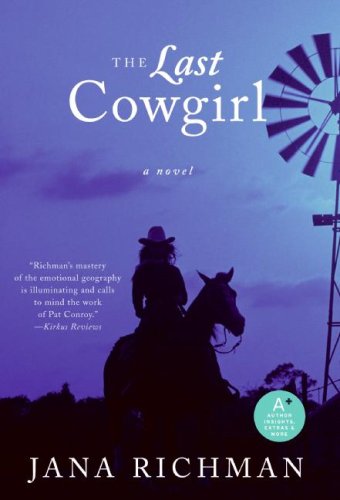
THE LAST COWGIRL
In the tradition of Pam Houston and Anita Shreve, a powerhouse new talent delivers an unforgettable emotional journey of loss, love, and healing.
Dickie Sinfield’s father had a dream: to be a real cowboy—an overpowering desire that propelled him to uproot his three children from their comfortable suburban cocoon and replant them on a dusty Utah ranch. Suddenly the young Dickie found herself herding cattle, attending rodeos, and wearing snap-button shirts. Proclaiming her disdain for this new life, Dickie refused to admit that deep down it suited her. But that was long ago, and now Dickie is as far from the ranch as possible.
In the tradition of Pam Houston and Anita Shreve, a powerhouse new talent delivers an unforgettable emotional journey of loss, love, and healing.
Dickie Sinfield’s father had a dream: to be a real cowboy—an overpowering desire that propelled him to uproot his three children from their comfortable suburban cocoon and replant them on a dusty Utah ranch. Suddenly the young Dickie found herself herding cattle, attending rodeos, and wearing snap-button shirts. Proclaiming her disdain for this new life, Dickie refused to admit that deep down it suited her. But that was long ago, and now Dickie is as far from the ranch as possible. Trading in cattle round ups for traffic jams, cowboy boots for heels, she’s become a successful journalist in Salt Lake City. Thanks to willful forgetfulness, she’s put the experience of the ranch behind her, until a family funeral pulls her back into her old world. As hard as she tries to deny it, a cowboy heart beats strong inside this big city girl, and now she must face both the past and some big decisions about her future.
- Avon A
- Paperback
- January 2009
- 320 Pages
- 9780061257193
About Jana Richman
Jana Richman is the author of Riding in the Shadows of Saints: One Woman’s Story of Motorcycling the Mormon Trail. She lives in Salt Lake City, UT.
Praise
“Richman’s mastery of the emotional geography is illuminating and call(s) to mind the work of Pat Conroy.” — Kirkus Reviews
“A warm story of good folks who make bad decisions and then have to live with them.” — Publishers Weekly
“Readers will be irrevocably drawn into this top-notch fictional debut from an amazing new talent.” — Booklist
“The Last Cowgirl is an engaging and good-humored read that shows how profoundly a person can be shaped by the landscape in which they grow up, whether they want to be or not.” —New West Magazine
Discussion Questions
The death of Dickie’s brother, Heber, sets off a chain reaction in Dickie’s life. Why would Heber’s death trigger such a strong reaction from Dickie when her mother Ruth’s death did not? Would Dickie have returned to Clayton if Heber hadn’t died?
Throughout her life Dickie’s relationships with other women have been complex. How did Dickie’s friendship with Holly shape her life and her decisions? How would you describe the relationship between Bev and Dickie? At one point Bev says to Dickie, “You often step aside when you ought to be stepping up.” What does she mean by this?
“I’m very near the edge of living life in the abyss between my mother’s sadness and my father’s stubbornness.” What does Dickie mean by this? How are pieces of Ruth and George portrayed in Dickie? In all their children?
The landscape in the novel is vividly rendered and it plays an important role—almost like an additional character. Each character also has a complex relationship with the Utah countryside. How have their lives, particularly Dickie’s, been shaped by the land, or by a separation from it? Could Stumpy ever be separated from the place? In other words, could Stumpy have moved into Salt Lake City and lived happily with Dickie?
